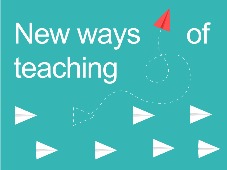Getting students back to stats class: A blended and challenge-based approach to teaching research skills

In this monthly blog about new ways of teaching, educators talk about their innovative, creative and impactful teaching initiatives. From unusual teaching methods to new technologies - everything is covered. How did these ideas come about and what impact does it have on students?
This month: Stefan Berger, Assistant Professor of Organizational Behavior at the Department of HRM & OB about the 'blended learning' technique.
University teaching: From the Great Transformation to the Great Resistance
The landmark impact of the Covid crisis on organizations’ work models is well-documented. After this “Great Transformation”, however, many organizations now face what Bloom (2022) termed the “Great Resistance”, as companies are grappling with the challenge of getting employees back in the office to foster face-to-face interaction.
If you are a lecturer, you know that universities face a Great Resistance, too. Student attendance rates have dropped dramatically compared to pre-Covid times, which is problematic because it harms community building and undermines the debate and discussion culture vital to academic education. Rather than simply blaming students for this trend, I argue that lecturers must take responsibility for finding ways to make classes more engaging and rewarding for students, combining virtual and in-person activities in a well-balanced manner.

Challenges in the course Research Skills for HRM
The course Research Skills for HRM, which seeks to prepare students for their research proposal and master thesis, is a prime example for this. Originally a classical lecture, students had to attend 7 in-person meetings, in which they “received input” on a variety of research- and statistics-related topics. Unsurprisingly, with a myriad of online tutorials on these topics freely available, attendance rates dropped substantially during the Covid pandemic. This, in turn, put additional strain on the teaching staff, as individual thesis supervisors had to make up for the deficient knowledge levels of students.
Students, too, were unhappy with the situation as they increasingly (and rightfully) questioned the benefits of showing up to the lectures. Moreover, with varying knowledge levels (e.g., when it comes to data analysis), parts of the students were overburdened in some lectures, while others felt that too little was demanded from them.
Solution: A blended and challenge-based course design
Supported by a FEB teaching innovation grant, these problems were addressed in a fundamental re-design of the course, guided by three principles: blended learning, challenge-based learning, and formative self-assessment.
Following a blended learning approach, all content- and process-related knowledge covered in the course was divided into 6 knowledge areas (for example, structure of a research paper, academic literature & writing, or data analysis), and subsequently split up in 45 knowledge units. For example, the knowledge area “academic literature & writing” covered the units literature search, literature management, and clear writing. For each knowledge unit, a 3–10-minute knowledge clip was published on the learning platform. Besides empowering students to watch the knowledge clips at their own pace and catering to their specific needs, this had the major advantage of freeing up time during the face-to-face tutorials.
To make the most out of this freed-up time (and overcome the great resistance), a challenge-based approach was adopted. Based on conversations with students and supervisors, the 5 major challenges that students face when conducting their master thesis projects were identified (for example, how to structure the introduction of a research paper?). In a dedicated tutorial for each challenge, students are now informed about strategies for dealing with these challenges and work actively on the implementation of potential solutions for their individual projects.
Finally, to link the online and in-person learning activities, short quizzes are presented at the beginning of every tutorial. The quizzes offer an opportunity for questions, discussion, and formative self-assessment to students, as well as a collective overview of student development to the lecturer.
Initial results look… promising!
While the formal course assessments of the students are not available, yet, a first positive development became visible during the tutorials already, as average student attendance levels increased notably compared to the previous semester. Above and beyond, thesis supervisors reported a shift in the students’ research skills, on average:

Importantly, teaching staff also benefited from the implemented changes. Half of the thesis supervisors who actively used the knowledge clips reported a reduction in the hours dedicated to the supervision of an individual student. Thereby, the average time reduction was estimated at two hours/student, which for a supervisor with four master thesis students adds up to a full workday. As hours assigned to thesis supervision are notoriously scarce, these savings take pressure from thesis supervisors and allow them to engage in other tasks or leave the workplace early – given that they decided to come to the office in the first place…
If you are interested in the ideas or implementing similar changes in your course, feel free to reach out.
Further reading
Sources
Bloom, N. (2022, July). The great resistance: Getting employees back to the office. Stanford Institute for Economic Policy Research. Available at: https://siepr.stanford.edu/publications/work/great-resistance-getting-employees-back-office
| Last modified: | 04 April 2023 10.10 a.m. |
More news
-
24 March 2025
UG 28th in World's Most International Universities 2025 rankings
The University of Groningen has been ranked 28th in the World's Most International Universities 2025 by Times Higher Education. With this, the UG leaves behind institutions such as MIT and Harvard. The 28th place marks an increase of five places: in...
-
05 March 2025
Women in Science
The UG celebrates International Women’s Day with a special photo series: Women in Science.
-
16 December 2024
Jouke de Vries: ‘The University will have to be flexible’
2024 was a festive year for the University of Groningen. In this podcast, Jouke de Vries, the chair of the Executive Board, looks back.
